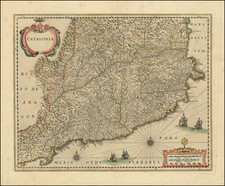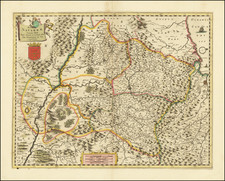Detailled plan of Sevilla, from Part IV Braun & Hogenberg's Civitatus Orbis Terrarum, the most important book of town plans and views published in the 16th Century.
Fine bird's-eye view plan of Seville with a key to 40 locations.
The following is translated from the original text on the verso:
This is a renowned city in the province of Hispania Baetica, situated on the Gulf of Cadiz, with a round shape and a large number of fine houses. It is the most important trade city in all Spain, and incredible quantities of goods from all parts of the world, but especially from India, arrive here. For the Sevillians have become so successful in trade that they have been granted the privilege above all others that no ship may sail to India without first coming here to take on board trade goods, war equipment, guns, provisions and soldiers and everything that is needed for such a voyage, in the name of the Spanish King. This also applies to ships arriving from India, [...] they must also moor in this city and offer their goods for sale here.
This is a bird's-eye view from the southwest of the city, built in a semicircular shape beside the Guadalquivir. The only tall building - which dwarfs the houses around it - is the cathedral, in its day the biggest in the world. In the left foreground, on this side of the river, the Castillo can be identified. The source of the city's wealth is indicated by the many ships that have come from the sea and moored in the harbour. The aqueduct in the upper right-hand corner is a reference to the city's Roman origins.
Georg Braun (1541-1622) was born and died in Cologne. His primary vocation was as Catholic cleric; he spent thirty-seven years as canon and dean at the church St. Maria ad Gradus, in Cologne. Braun was the chief editor of the Civitates orbis terrarum, the greatest book of town views ever published. His job entailed hiring artists, acquiring source material for the maps and views, and writing the text. In this role, he was assisted by Abraham Ortelius. Braun lived into his 80s, and he was the only member of the original team to witness the publication of the sixth volume in 1617.
Frans Hogenberg (ca. 1540-ca. 1590) was a Flemish and German engraver and mapmaker who also painted. He was born in Mechelen, south of Antwerp, the son of wood engraver and etcher Nicolas Hogenberg. Together with his father, brother (Remigius), uncle, and cousins, Frans was one member of a prominent artistic family in the Netherlands.
During the 1550s, Frans worked in Antwerp with the famous mapmaker Abraham Ortelius. There, he engraved the maps for Ortelius’ groundbreaking first atlas, published in Antwerp in 1570, along with Johannes van Deotecum and Ambrosius and Ferdinand Arsenius. It is suspected he engraved the title page as well. Later, Ortelius supported Hogenberg with information for a different project, the Civitates orbis terrarium (edited by Georg Braun, engraved by Hogenberg, published in six volumes, Cologne, 1572-1617). Hogenberg engraved the majority of the work’s 546 prospects and views.
It is possible that Frans spent some time in England while fleeing from religious persecution, but he was living and working in Cologne by 1580. That is the city where he died around 1590. In addition to his maps, he is known for his historical allegories and portraits. His brother, Remigius, also went on to some fame as an engraver, and he died around the same time as his brother.












![[Galicia & Asturias] Le Royaume de Galice Divise en plusieur Territoires et Les Asturies Divisees en Asturie D'Oviedo et de la Santillana Dressez Sure les Memoires de Rodrigo Mendez Silva . . . 1704](https://storage.googleapis.com/raremaps/img/small/33010mp.jpg)

![[ Gipuzkoa - San Sebastian ] Nova et Exactissima Descriptio Nobilis provinciae Guipuscovae in partibus Hispanae sitae](https://storage.googleapis.com/raremaps/img/small/75169.jpg)